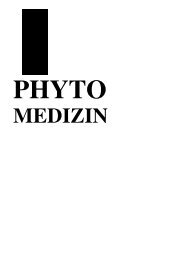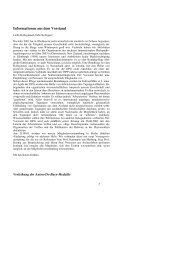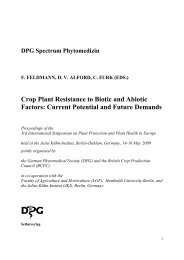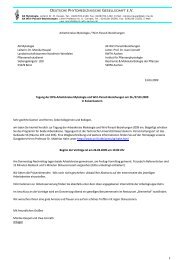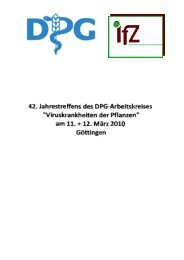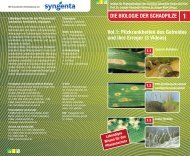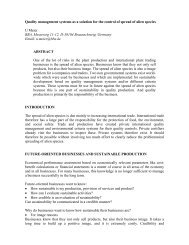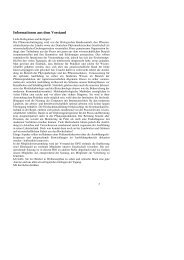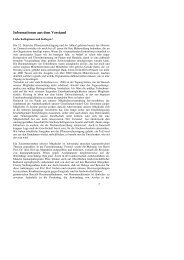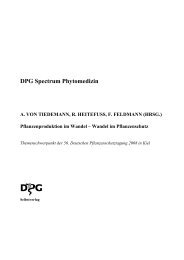PHYTO MEDIZIN Mitteilungen der Deutschen ... - Die DPG
PHYTO MEDIZIN Mitteilungen der Deutschen ... - Die DPG
PHYTO MEDIZIN Mitteilungen der Deutschen ... - Die DPG
Erfolgreiche ePaper selbst erstellen
Machen Sie aus Ihren PDF Publikationen ein blätterbares Flipbook mit unserer einzigartigen Google optimierten e-Paper Software.
cell movement within plants. By use of two-hybrid system, we identified<br />
BC1-interacting plant factors, which are currently un<strong>der</strong> investigation.<br />
Interaction between Cowpea mosaic virus movement tubules and the<br />
plasma membrane<br />
JWM van Lent 1 , J Pouwels 2 , M Rolloos 1,2 , CM Carvalho 1 , J Wellink 2 and RW Goldbach<br />
1; 1 Laboratory of Virology, Wageningen University and 2 Laboratory of Molecular<br />
Biology, Wageningen University<br />
Cowpea mosaic virus (CPMV) virions traverse the cell wall through nanotubules<br />
that are assembled from the viral movement protein (MP). In planta<br />
these tubules are found exclusively in the plasmodesmal canal. In isolated<br />
plant protoplasts, devoid of cell walls and plasmodesmata, a similar polarity<br />
of tubule assembly is observed. The MP anchors somehow at the plasma<br />
membrane (PM) and from there an outward growing tubule is assembled<br />
tightly encased with PM as also occurs within the plasmodesma. Transport<br />
tubules are not only formed in protoplasts of host plants, but also in those<br />
isolated from non-host plants or even animal cells that express the MP. Obviously,<br />
MP interacts with the PM or with PM-associated proteins and such<br />
proteins should be conserved in plant and animal cells. This intriguing interaction<br />
between MP and PM was further analyzed by MP-mutant analysis,<br />
timelapse microscopy and FRET/FRAP studies. It has been shown before<br />
that prior to tubule formation, MP (-GFP) accumulates in so-called peripheral<br />
punctate spots at the PM and it was speculated that these were the nucleation<br />
sites for tubule assembly. Time-lapse fluorescent microscopy was performed<br />
on protoplasts expressing MP-GFP and showed that the punctate spots are<br />
dynamic structures that are immobilized at the PM and that tubules indeed<br />
arise from (a sub-population of) these spots. To investigate the interaction of<br />
tubules with the surrounding PM, the diffusion herein of small and large<br />
fluorescent PM-associated proteins was examined by fluorescence recovery<br />
after photobleaching (FRAP). These studies indicate that tubules made by<br />
CPMV MP do not interact directly with the PM, but most likely via a PM<br />
intrinsic protein (PIP) or otherwise associated host protein. Using affinity<br />
chromatography it was found that purified MP a.o. binds to aquaporin present<br />
in the plasmamembrane. Transient expression of MP-YFP and Arabidopsis<br />
aquaporin P1;4-CFP revealed that these proteins colocalize in punctuate spots<br />
on the surface of cowpea protoplasts. Acceptor photobleaching experiments<br />
indicate that they also physically interact at these sites, suggesting that aquaporin<br />
is used by the virus as a primer for the tubule formation at the plasma<br />
membrane.<br />
12



